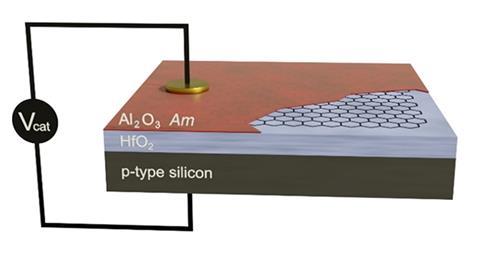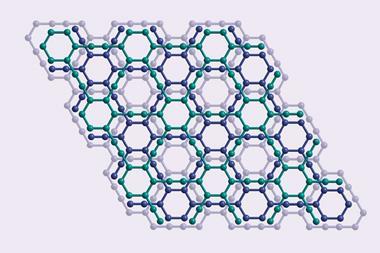
A new instrument that can fine tune the properties of a catalyst has been developed by US scientists. The ‘catalytic condenser’ can make cheap and abundant metals act like more expensive ones by simply varying the applied voltage. With the new device, it’s now also possible to bypass the ‘speed limit ’ that governs each catalyst, opening new opportunities in energy research and other exciting areas.
Paul Dauenhauer from the University of Minnesota explains that the catalytic condenser accumulates electrons or holes in a catalyst film, thereby modifying its electronic and catalytic properties. ‘We can now change the catalyst as fast or faster than the chemistry occurs,’ he says.
Traditionally, catalysts have been metals and metal oxides that are static. ‘They remain the same for months and years while reactions happen on their surface,’ Dauenhauer says. ‘These catalysts have inherent limits of speed and selectivity to products.’ He notes that until now, important reactions like making hydrogen from water or synthesising ammonia have been limited by the Sabatier principle, which states that the interactions between a catalyst and a substrate must be very precise for that catalyst to be effective. ‘We already have materials that achieve this speed limit, and the reactions are far too slow to be viable for the technologies required to address problems such as climate change.’
The new catalytic condenser allows for electrons to be added and removed from a material’s surface at high speed. ‘Catalysts can now be rapidly designed via electronic dials, rather than expensive, slow, iterative synthesis, characterisation, and testing,’ points out Dauenhauer. ‘This is an entirely new dimension in catalyst research.’
The device has four key components. Starting with a silicon wafer, the researchers first grew a thin, electrically insulating hafnium oxide layer on it, then added a conductive graphene sheet and finally deposited the catalyst itself – in this case, an alumina film. ‘By applying a voltage difference between the conductive silicon wafer and the graphene/catalyst layer, electrons accumulate on one side and holes accumulate on the other. When you get enough electrons or holes in the catalyst layer, the material takes on new catalytic properties,’ explains Dauenhauer. ‘In the case of the alumina-on-graphene catalytic condenser, about 12% of an electron was removed from the catalyst for every place where chemistry could occur – this is a large variation in electronic properties.’
The instrument builds upon catalytic resonance theory, which was developed by Dauenhauer and colleagues in 2019 and predicts that rates far beyond the Sabatier limit can be achieved if the catalyst itself can change with time. ‘Because electrons move quickly in materials such as graphene, the current device can operate at 1000 hertz,’ says Dauenhauer. ‘As a platform device, the condenser can have an active surface of any metal and hundreds of possible metal oxides, which opens the door to operate catalysts dynamically for thousands of chemical manufacturing applications.’ He mentions that this has already been shown with computational models of the ammonia synthesis reaction.
‘Changing one metal to act like another is beneficial when using inexpensive, less active and less selective catalysts,’ says Kandis Leslie Gilliard-AbdulAziz at the University of California, Riverside, who was not involved in the study. ‘This is often an issue when attempting to substitute expensive precious metal catalysts, such as platinum, iridium and rhodium, with lower-cost transition metals such as nickel, iron or cobalt.’
Dauenhauer adds that the catalytic condenser is programmable. ‘We can switch a catalyst between two different states by applying a sinusoidal oscillation in the voltage, but more complex programs are possible too. In the future we will be creating and optimising condensers and programs together for advanced control of chemistry.’
References
T Ming Onn et al, J. Am. Chem. Soc Au, 2022, DOI: 10.1021/jacsau.2c00114












No comments yet